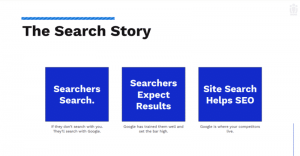Typically, when Google makes a change to its algorithm, website developers are left in the dark. We don’t know when they’re coming or what the change is. If we did, then it might allow us to “game the system” to ensure that our websites have just the right bells and whistles to rank the best in search results…
 So, website developers around the world snapped to attention when Google announced last month that “As more people use mobile devices to access the internet, our algorithms have to adapt to these usage patterns.”
So, website developers around the world snapped to attention when Google announced last month that “As more people use mobile devices to access the internet, our algorithms have to adapt to these usage patterns.”
This prefaced their announcement that:
“Starting April 21, we will be expanding our use of mobile-friendliness as a ranking signal. This change will affect mobile searches in all languages worldwide and will have a significant impact in our search results.“
As Chuck Price from Search Engine Watch put it “In the world of SEO, hummingbirds, pandas, and penguins are akin to the Horsemen of the Apocalypse.”
It’s this prevailing opinion that has led developers to refer to this impending algorithm change as “Mobilegeddon.”
So what does that mean for you?
If you’re not heavily steeped in the world of website design and SEO, it may simply sound scary and confusing. As an author or a speaker, you want your website to be a place for your readers and audience to connect with you. As a business professional, you need your site to rank well so that people can hire you or buy your products and services. Your website is an extension of what you do, and if it’s not getting found in the search engines, it can have a profound impact on your bottom line.
However, the good thing about all of this is that Google has given you warning. You have the better part of a month to test your site, make sure its mobile-friendly, and make any necessary changes so that your site is not negatively impacted by this algorithm change.
For some, this may harken back to Y2K, where we all did a lot of scrambling to make sure that computer systems around the world didn’t crash when the new millennium rolled around on January 1, 2000.
While it’s not as dire as all of that, it is important.
Search engine rankings determine how easy it is for people to find you and your website.
Since so many people access the internet now from mobile devices, it makes sense that Google would refer people to easily consumable content. If the site can’t be displayed easily on a mobile device, then visitors can’t easily consume the content. Hence the ding to your search results.
Okay… So, now what are you going to do about it?
Start here. Visit the Google Webmasters site to check the mobile-friendliness of your site.
If Google says you’re good to go, that’s great!
However, if it identifies errors, it’s time to start working your way through resolving the issues. (If you registered your site with Google’s Webmaster Tools, you may already have received an e-mail from Google telling you that there are issues to resolve with your mobile site.)
Google provides useful instructions on how to correct the most commonly found errors. So you can try to fix the problems yourself, or you can send the report to your website developer and ask them to resolve the issues for you. Make sure you do this sooner rather than later because you want to make sure that all necessary changes are implemented before the algorithm update takes place on April 21st.
Ultimately, there are two options when it comes to mobile-friendly sites, and they both have their pros and cons.
Create a mobile version of your website. This is separate from your existing website, and is presented specifically to users when they access your site from a mobile device. While it’s possibly a quicker and cheaper way to resolve issues of mobile-friendliness (and allows you to target your content specifically to mobile users), it is a separate instance of your website. That means double maintenance of your content. What you post on your main website would also need to be created on your mobile site.
Ensure your websites uses a theme that is mobile-responsive. This means that the theme instructs the device on how to configure your content to be displayed to maximum effect based on the device in use. It’s less maintenance long-term, but if your existing theme is not mobile-responsive, it could mean you’re trying to get a site redesign done in the next five weeks. That most effort and more money to be spent now, but with a greater long-term benefit. Thankfully, if your existing theme is already mobile-responsive, then it’s just a matter of working your way through the issues identified by Google to ensure that your design is working to maximum effect.
For what it’s worth, Google has long supported having a mobile-responsive website over having a dedicated mobile website. It makes for a better user experience and is less prone to errors.
Either way, time is short. I encourage you to check your site today and start thinking about what needs to be done to ensure that your site isn’t penalized by this algorithm update. Otherwise, come April 21st, you may see a dramatic dip in traffic to your site coming from search referrals.
(226)








